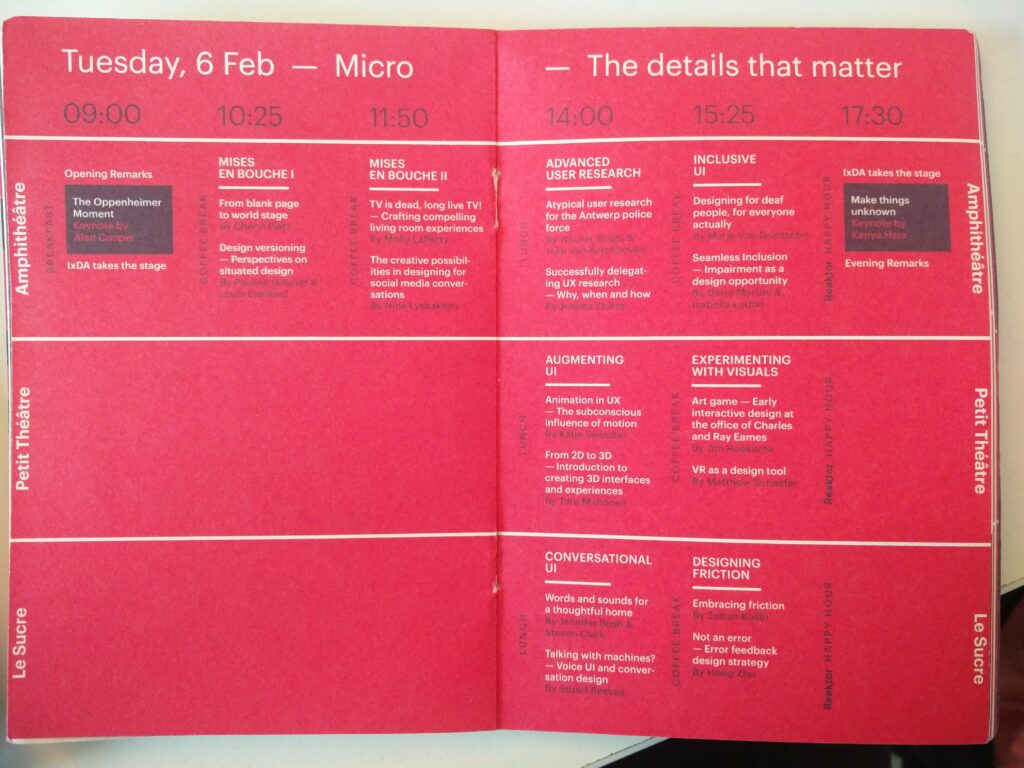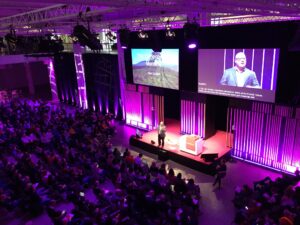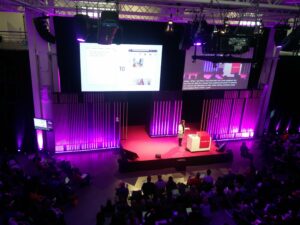After following Quentin, UX-Designer & Marketing Manager @UX-Republic between a chase to catch his train, an Adobe Xd discovery workshop and a cocktail at the Musée des Confluences, we find our great reporter for his meeting with Mr. Alan Cooper. Will he have offered her flowers, chocolate or her t-shirt, find out in the rest of her adventures.
D-Day !
I have my eyes open in my bed, I look at the ceiling, I wait for the alarm clock to ring… today I meet Alan. I'm sure he's waiting for me too.
I get dressed in a hurry (or did I sleep dressed? I don't know), I meet my friends in the hall and we go to La Sucrière where the conferences of the day are going to take place. The program will be busy, there will be Alan and the plenaries this morning then we will be divided into three spaces in the huge building for the afternoon, a little appetizer:

- The Oppenheimer Moment, Alan Cooper
- From blank page to world Stage, Cheryl Platz
- TV is dead, long live TV — crafting compelling living room experiences, Molly Lafferty
- The creative possibilities in design for social media conversations, Nina Lysbakken
- Animation in UX — The subconscious influence of motion
- art game — Early interactive design at the office of Charles and Ray Eames
Of course, there were others, all brought their share of interests, new and interesting notions, but choices had to be made and these are the ones that marked me. For those who are interested in the program, the whole thing was filmed and broadcast on Vimeo.

The Oppenheimer Moment, Alan Cooper
That's it, we're in place, we're waiting for the big moment. Interaction 18 is a bit of an American show with light effects, entrance music, stage and giant screens subtitled in real time, but it's also, for the occasion, very French, we're in a beautiful place full of history, even if it is crowded it remains on a human scale and everyone seems accessible and happy to be there.
Alan arrives, my heart is beating. He has suspenders on his shirt and he's grown a little mustache since the last time I saw him (on video of course), it gives him a wise and benevolent air, a UX Design dad who comes to deliver his message to us to open the show. And what a message! Honestly, it's good to hear this type of speech, coming from an American moreover, who simply comes to tell us that we have to stop the race for profit and money to refocus on the essential and ask yourself the question of being a “good Ancestor”, to leave a lasting mark for our children, something that we can be proud of and that makes sense.
It would be long and tedious to transcribe here all his speech and I strongly invite you to go and listen to it via the video link posted a little higher but here is what I retain in broad outline.
IxDa is about user centric design, not designer centric design
From the top of his desk, Cooper poses the problem of the diversion of our best innovations into malicious, even harmful actions or services (example: the atomic bomb. Basically a major advance for scientific research and the community of physicists which becomes the deadliest weapon in human history).
It's done through a mechanism that we don't really understand where no one is to blame, it's a systemic issue. A certain number of “small” problems, deviations that we do not necessarily think of when we try to respond to a specific problem, can turn out to be disastrous on the scale of a system as a whole.
This is where the question of responsibility arises, of all of us but particularly of us designers, when we think of the solutions of tomorrow. To avoid this kind of disaster, or at least try, Mr Cooper offers a kind of method to ask the right questions at the right time: “the Ancestry Thinking”
- What are our assumptions?
- What are our externalities?
- What Timescale are we using?
- Tactical tools to ancestry thinking
Working backwards
"Working backward" can be a solution to ask yourself these good questions, a bit like the "5 whys" method, step back and examine the surroundings of the problem, take a step back and understand the context, question the cause rather than try to answer the specific question. The best solution between option A and option B is often option C.
Forget the profit and think first of the quality, then the benefits will come by themselves.
Profit is a product of quality
We can't change the system, it's not possible, but we can have micro actions, at our level as a person. It's not a rebellion either, and we shouldn't systematically question all of our work on the pretext that business isn't the priority, it's more a question of dialectics. We have the power, as a person, as a designer, to take the time to think of the solutions in a sustainable way, to take into account the possible drifts and to correct them while they are still very small problems, have not yet reached the global system.
It may seem a bit conceptual transcribed in this way but this speech was devilishly inspiring and set the tone of this day under the sign of responsibility and ethics. Thank you Mr Cooper, I am satisfied!
I took the time to detail a little this conference that was close to my heart but I will try to bring out the essentials of the following ones.

From blank page to world Stage, Cheryl Platz
Cheryl Platz, Senior Designer for Amazon and then Microsoft wondered how to design a product, from a blank sheet to arrive at an internationally renowned product, here is a summary of her advice:
Solutions are not found overnight, it is normal not to have all the answers.
1. Seek the truth
Be in search of the truth. Not only trying to understand exactly what people expect by putting yourself in their shoes and not by imagining what they might need (staying well focused on the factual elements of research and behavioral study) but also proposing a product who does not lie, who does not cheat on what it is and what it is used for.
2. Find the Icebergs
Identify the problems upstream, deal with them right away and consider all the points that could cause us to miss.
3. Inspire allies with your story
Motivate project stakeholders, take concrete cases in the news, the media, culture, relate to them and anchor the project in reality. Take care of history and story telling. Share your research, let the arguments speak for themselves. Share the vision of the product, quickly show a prototype or what you are aiming for.
4. Solve old problems in NUI way
NUI for Natural User Interface, or how to limit friction by using a variety of mechanisms reproducing human behavior such as voice, gestures, touch or facial expressions.
5. Embrace change but stay the course
Consider change and innovation but keep the course and the initial need well in mind. Users have their habits and will prefer what they know how to do rather than relearning it.
After these first two conferences, the level looks high, I'm delighted and it's time to take a break. I go for a walk in the levels of the Sucrière, going from stand to stand, choosing the next interventions I would like to attend. Continuation and end tomorrow therefore, in a future article.
In the meantime, I forgot the flowers, I didn't offer her chocolate and I didn't even speak to her, but I saw Alan Cooper, I can leave in peace!
Quentin, Marketing Manager & UX Coach @UX Republic
UX/UI ECO-DESIGN # Paris
SMILE Paris
163 quay of Doctor Dervaux 92600 Asnières-sur-Seine
DESIGN THINKING: CREATING INNOVATION # Belgium
UX-REPUBLIC Belgium
12 avenue de Broqueville - 1150 Woluwe-Saint-Pierre
MANAGING AND MEASURING UX # Paris
SMILE Paris
163 quay of Doctor Dervaux 92600 Asnières-sur-Seine
DESIGN SPRINT: INITIATION & FACILITATION # Paris
SMILE Paris
163 quay of Doctor Dervaux 92600 Asnières-sur-Seine
UX-DESIGN: THE FUNDAMENTALS # Belgium
UX-REPUBLIC Belgium
12 avenue de Broqueville - 1150 Woluwe-Saint-Pierre
GOOGLE ANALYTICS 4 #Paris
SMILE Paris
163 quay of Doctor Dervaux 92600 Asnières-sur-Seine
ACCESSIBLE UX/UI DESIGN # Belgium
UX-REPUBLIC Belgium
12 avenue de Broqueville - 1150 Woluwe-Saint-Pierre
EXPERIENCE MAPPING # Paris
SMILE Paris
163 quay of Doctor Dervaux 92600 Asnières-sur-Seine












